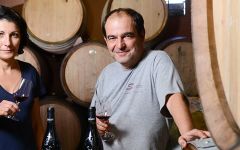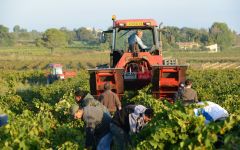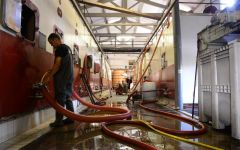Domaine de la Janasse Chateauneuf-du-Pape Vieilles Vignes (1.5 Liter Magnum) 2017
-
Jeb
Dunnuck -
Robert
Parker -
James
Suckling



Product Details
Your Rating
Somm Note
Winemaker Notes
In contrast to Chaupin, which is made from old-vine Grenache on sandy soils, the cuvée Vieilles Vignes is from old vines of Grenache, Mourvedre, Syrah along with smaller percentages of other permitted varieties that are grown in these old vineyards. The wine is sourced from 4 terroirs: pebbly clay, sand, gravelly red clay and sandy limestone.
Professional Ratings
-
Jeb Dunnuck
The 2017 Châteauneuf Du Pape Cuvée Vieilles Vignes is another killer effort from this estate. Coming from the La Janasse and La Crau lieux-dits and brought up in foudre, its deep purple color is followed by blockbuster notes of crème de cassis, blackberries, chocolate, graphite, and earthy, rocky, mineral-like nuances. It's deep and full-bodied, with a ripe, powerful yet balanced style and a great finish. A classic example of this cuvée. it's going to benefit from short-term cellaring and keep for two decades or more.
-
Robert Parker's Wine Advocate
The 2017 Chateauneuf du Pape Cuvee Vieilles Vignes derives from parcels planted on classic clay and galets roulés soils. It's 65% Grenache, 20% Mourvèdre, 10% Syrah and 5% other varieties. Tight, intense, even clenched, it's in need of several years' cellaring before it becomes truly enjoyable to drink. For now, those gorgeous black cherries are restrained behind a firm wall of tannins. Full-bodied and rich, this is ripe, it just requires patience.
-
James Suckling
There’s less grenache here in 2017 (60%); the balance is made up of syrah and mourvedre, all from 80 to 100 years of age. The richness and depth here is really impressive, as is the freshness of ripe berries and a dark and quite dense, plum and black-cherry burst at the finish. The palate has a very supple, succulent and juicy feel. Some firmness to the tannins and good drive with a silky edge. Try from 2024.
Other Vintages
2021-
Wine
Spectator -
Jeb
Dunnuck -
James
Suckling
-
Robert
Parker -
Jeb
Dunnuck - Decanter
-
Wine
Spectator - Vinous
-
Wine
Enthusiast -
Robert
Parker - Decanter
-
Jeb
Dunnuck -
Wine
Spectator -
James
Suckling
-
Robert
Parker -
Wine
Spectator -
Jeb
Dunnuck
-
Jeb
Dunnuck -
Wine
Enthusiast -
Wine
Spectator -
Robert
Parker - Decanter
-
Robert
Parker -
Wine
Spectator -
Jeb
Dunnuck -
James
Suckling
-
Wine
Spectator -
Robert
Parker
-
Wine
Spectator -
Robert
Parker
-
Robert
Parker -
Wine
Spectator
-
Robert
Parker -
Wine
Spectator
-
Robert
Parker -
Wine
Spectator
-
Wine
Spectator -
Robert
Parker
-
Wine
Spectator -
Robert
Parker
-
Robert
Parker -
Wine
Spectator
-
Robert
Parker -
Wine
Spectator
-
Robert
Parker -
Wine
Spectator
-
Robert
Parker -
Wine
Enthusiast -
Wine
Spectator
-
Wine
Spectator -
Robert
Parker
-
Robert
Parker
-
Robert
Parker
-
Robert
Parker
-
Robert
Parker






Domaine de la Janasse has quickly become one of the Superstar estates of Chateauneuf-du-Pape. Led by the dynamic Christophe Sabon, the estate combines the best of both traditional and modern techniques to craft a collection of truly riveting wines from “simple” value-priced VDP’s to benchmark Chateauneufs.
The estate was founded in 1976 by Aimé Sabon, Christophe’s father, who still oversees the vineyards and farms organically. The property consists of 40 Hectares, spread over as many as 70 different parcels throughout the appellation.
While Aime works in the vineyards, his son, Christophe Sabon, is in charge of wine production. Christophe is a self-proclaimed “great defender of Grenache,” which still represents 75% of their vines. He manages the common rusticity of Grenache-based wines through meticulous work in the vineyards and cellar. The result is a wide range of lavishly ripe, extracted Chateauneuf-du-Papes and Cotes-du-Rhônes that are complex and yet balanced with acidity -- often in contradiction to an appellation better known for sheer exuberance and power. As Robert Parker points out: “The young and talented Christophe Sabon continues to display the sure-handed touch of a veteran winemaker”.

With bold fruit flavors and accents of sweet spice, Grenache, Syrah and Mourvèdre form the base of the classic Rhône Red Blend, while Carignan, Cinsault and Counoise often come in to play. Though they originated from France’s southern Rhône Valley, with some creative interpretation, Rhône blends have also become popular in other countries. Somm Secret—Putting their own local spin on the Rhône Red Blend, those from Priorat often include Merlot and Cabernet Sauvignon. In California, it is not uncommon to see Petite Sirah make an appearance.

Famous for its full-bodied, seductive and spicy reds with flavor and aroma characteristics reminiscent of black cherry, baked raspberry, garrigue, olive tapenade, lavender and baking spice, Châteauneuf-du-Pape is the leading sub-appellation of the southern Rhône River Valley. Large pebbles resembling river rocks, called "galets" in French, dominate most of the terrain. The stones hold heat and reflect it back up to the low-lying gobelet-trained vines. Though the galets are typical, they are not prominent in every vineyard. Chateau Rayas is the most obvious deviation with very sandy soil.
According to law, eighteen grape varieties are allowed in Châteauneuf-du-Pape and most wines are blends of some mix of these. For reds, Grenache is the star player with Mourvedre and Syrah coming typically second. Others used include Cinsault, Counoise and occasionally Muscardin, Vaccarèse, Picquepoul Noir and Terret Noir.
Only about 6-7% of wine from Châteauneuf-du-Pape is white wine. Blends and single-varietal bottlings are typically based on the soft and floral Grenache Blanc but Clairette, Bourboulenc and Roussanne are grown with some significance.
The wine of Chateauneuf-du-Pape takes its name from the relocation of the papal court to Avignon. The lore says that after moving in 1309, Pope Clément V (after whom Chateau Pape-Clément in Pessac-Léognan is named) ordered that vines were planted. But it was actually his successor, John XXII, who established the vineyards. The name however, Chateauneuf-du-Pape, translated as "the pope's new castle," didn’t really stick until the 19th century.
